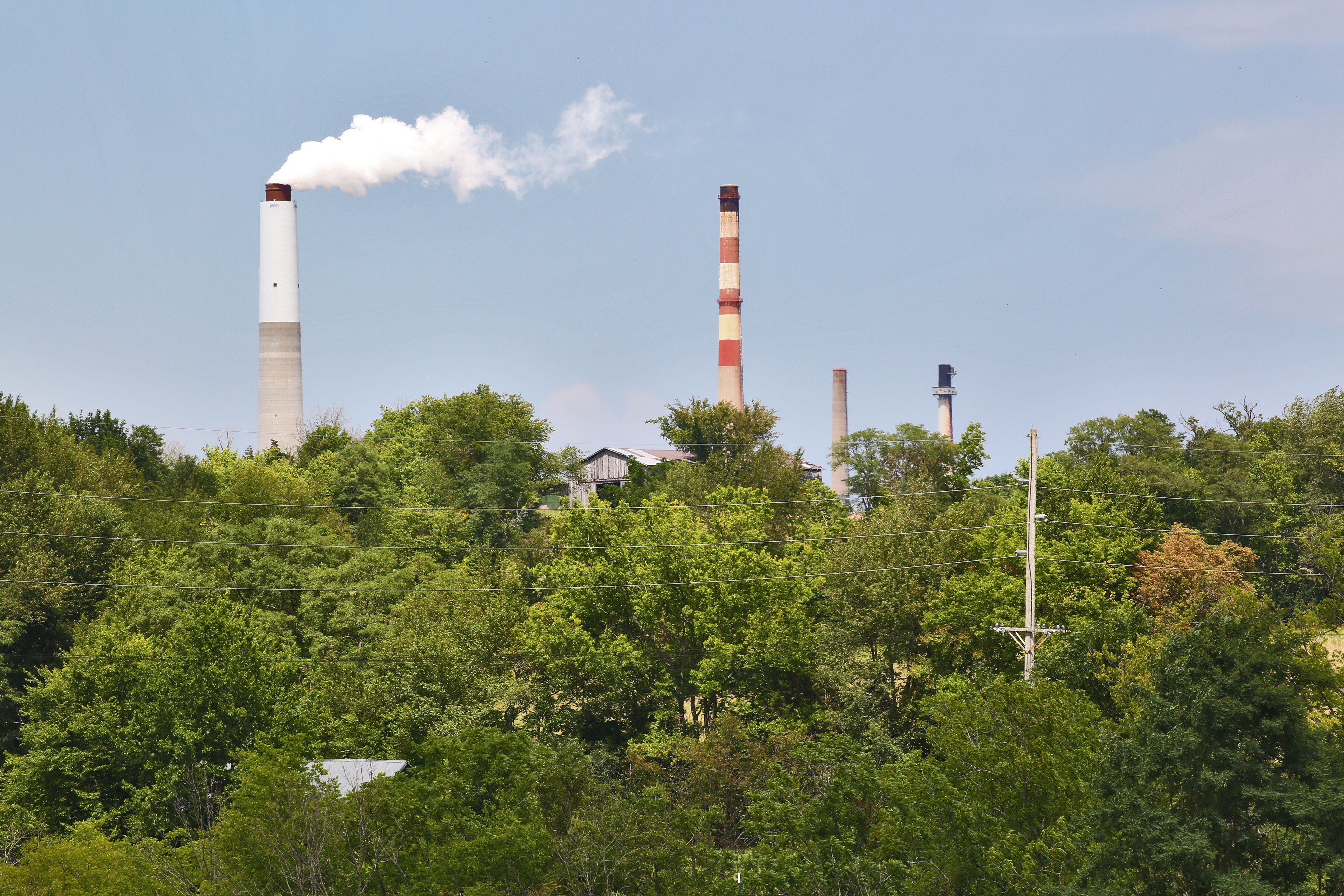Groups file lawsuit against KU to protect Herrington from leaking coal ash piles
Published 11:13 am Saturday, July 15, 2017

- Ben Kleppinger/ben.kleppinger@amnews.com
Towers at the E.W. Brown power plant rise over farmland in Mercer County Friday afternoon.
A federal lawsuit was filed Thursday on behalf of plaintiffs against Kentucky Utilities, seeking cleanup of toxic coal ash waste at the E.W. Brown power plant that is leaking pollution into Herrington Lake.
Filed by Earthjustice, an organization which calls itself “the legal backbone for thousands of organizations, small and large,” the suit is backed by the Sierra Club and Kentucky Waterways Alliance. It seeks to protect the lake, which is not only a huge recreational destination but supplies drinking water for tens of thousands of people.
E.W. Brown has been burning coal since the ’50s and storing its toxic coal ash leftovers in a pit that directly impacts the lake, says Tom Morris. He’s the chairman of the Sierra Club Cumberland Chapter. “It’s sad that the only way to do anything about it is to wait to find out what the toxic slush does to harm the lake. Well, we found it hurting our fish population already, so we are acting before anything else shows up.”
The environmental groups’ lawsuit requests that the federal court in Lexington order KU to stop coal ash pollution from flowing into Herrington and clean up the existing contamination.
Although there have been some remedial measures taken by KU, multiple news reports site documents showing the water is contaminated due to arsenic and selenium leached from the power station ash pond into groundwater and into Herrington Lake. Fish tissue sampling has shown the runoff poisons fish and other aquatic life.
“Kentucky Utilities is not above the law,” said Earthjustice attorney Thomas Cmar. “No company, no matter how big, has the right to pollute our public water supplies.”
Ward Wilson, executive director of the Kentucky Waterways Alliance, says it has tried for years to get the releases stopped, but to no avail.
“Now we feel legal action is necessary to promptly correct this threat to wildlife and water quality that has been going on for too long already,” Wilson says.
Earthjustice says the E.W. Brown power plant has at least 6 million cubic yards of buried coal ash that sit in contact with groundwater flowing into the lake. The organization says KU — an affiliate of Louisville Gas & Electric — has conducted testing that showed contaminants (arsenic, selenium and boron, for instance) have gotten into the groundwater, and other tests by the Kentucky Division of Water found that 9 out of 10 fish samples collected near the plant had levels of selenium in violation of Kentucky water standards.
Company’s response, attorney’s argument
“We don’t think we’re in any violations,” says Chris Whelan, vice president of communications for KU. “We firmly believe that we are in compliance and we’re prepared to defend our case in court.”
Whelan says KU closed its main ash pond in 2008, and the auxiliary pond is already lined but is slated to be closed by 2019, an agreed-upon timeline with the state.
But attorney Cmar with Earthjustice says it’s not as simple as being in compliance.
“It is true that the company is currently working with the state on a plan to monitor the situation, but they’re not currently undertaking any efforts which would directly address the underlying problem —- which is the 6 million cubic yards of toxic ash coal buried next to the shore.”
Whelan says the lawsuit was not a surprise; KU was given a notice of intent to sue a couple of years ago, but Sierra Club “held off for some reason.” She says, “For them to sue a coal-fired plant is really not uncommon.”
Cmar says the lawsuit wasn’t held off — testing and research was being done, as well as interviews of lake residents.
“And we work with scientists who have studied the problems associated with coal ash pollution around the country, so yes — this is a familiar story, where you have coal ash in contact with ground water, especially in an area like Herrington Lake …” Cmar says, where under the surface is a form of Karst topography. This refers to a landscape formed from the dissolution of soluble rocks, characterized by underground drainage systems with sinkholes and caves.
Whelan also says the water near the plant has been surveyed by the state and it “found no evidence of contamination of the water supply. And the City of Danville has confirmed this, as well. We believe we’re in total compliance.”
Yes, but that’s the only good news, Cmar says. “No contamination of the drinking water supply” simply refers to the water after it’s been treated.
“It hasn’t reached that point, yet. We don’t see evidence that there’s an immediate harm in human health from contact with the water or its use as drinking water. But that’s a different point from what we’re seeing now — which is the high levels of toxins in the fish and a concern that as long as there’s this ongoing source of contamination, things could degrade over time.”
Whelan says a gypsum pond on site will be lined, eventually. “But it takes time for these things to happen, they do not happen overnight.”
Whelan says as far as the selenium and arsenic, “They are naturally occurring materials that can appear in dirt as well as coal ash. They are in the dirt. We’ve said we’re not in violation, we have a continued order by the state to monitor it and we have. We believe we’re within our regulations.”
Cmar says this is not acceptable.
“The company’s approach seems to be ‘let’s wait and see, and continue studying this issue for years’ … We already know the state obtained their own sampling in May. They collected 10 fish near the plant and tested the tissue in those fish, and nine out of 10 came back with levels of selenium higher than the allowed standards — significantly higher.”
Cmar says due to the Karst topography, the water is flowing in a lot of different directions. “It’s very common to have situations where it’s going to make its way out through the ground water and to nearby water bodies. Here, there is no other source that would explain the high amounts of selenium and other elements, which are contained in coal ash, that could explain it.”
The testing indicated there is significant harm happening to the fish population now. “Fish are not reproducing as well, not developing as well as young fish, and it’s degrading the population. These are early warning signs that mean harm is happening now, and if action is not taken to eliminate the source, it could get worse.”
Cmar says the reason the organizations aligned to take the step in suing is due to not seeing any other way through which they could get the concerns of the folks living on the lake heard. At least not in a process that would lead to progress.
“We’d love it if the company would take some additional steps to avoid it, but their plan is now to study the problem and find other sources to blame the problem on. The 6 million tons of coal ash buried next to the lake is the elephant in the room. They’d rather spend their own rate-payers’ money and time to look for others to blame … ” Cmar says. “We’re asking the court to hold the company accountable for cleaning up the toxic mess they’ve generated over many, many years.”
The state’s action plan
Lanny Brannock, spokesperson for the Division of Water, and its director, Peter Goodmann, both say: the water in Herrington Lake is safe. There’s no impact on drinking water, it’s OK to fish, eat the fish and swim.
“There’s a statewide mercury advisory, but that’s out for everyone. As long as those guidelines are followed with fish they’re taking from the lake, they should be fine,” Brannock says. “We want to dispel any myths that it’s a big polluted mess, because it’s not.”
Goodmann says there’s a fine distinction between the fish coming up with elevated measures, and anything being found in the water supply.
“We have found elevated selenium measures in the fish, and that’s what spurred the action,” Goodman says, referring to the work the division has done with KU for “sometime” regarding the coal ash. KU was ordered to make changes via Kentucky’s Antidegradation policy — an enforcement action. But the elevated measures are not being found in the water alone, he says. Selenium doesn’t get through fish tissue through water, it goes through the foodchain.
“You may have a source of selenium, but the dilution factor is really high. The fish around the discharge (of the water plant) measured significantly higher than fish found further away, which is what the investigation is all about,” Goodmann says. Selenium is not a particularly big health concern, he says.
“The impairment problem comes with fish reproduction, that’s what it affects,” Goodmann says.
“We received the company’s corrective plan they submitted to us as required by an agreed order we had with them,” Brannock says. “The company has since reworked that and submitted it back to us, and we’re reviewing it as we speak. We’re very aware of the issue, working with the regulated entity, and we hope to get a resolution soon. Can’t tell you the exact timeline, but it’s around the corner.”
Goodmann and Brannock both say their division is looking to identify the issue, determining the extent of the issue and employing a solution.
“We have to understand the extent of the problem first,” Goodmann said. “We’ve been trying to expedite this to get it done. We would like them doing the sampling on the fish tissue this season. The lawsuit doesn’t have anything to do with spurring us on.”
A resident speaks out
Julie Pease and her husband, David, moved to live on the lake five years ago. She says they attempted to research the water quality.
“Obviously, even before we made the move, we were concerned about the water quality. I researched it a bit. There were never any ‘great’ reviews, but nothing horrid,” Pease says. “Then we moved down here and heard horror stories.”
She says the Herrington Lake Conservation League has helped tremendously with surface clean-up, but the problem with the lake goes much deeper.
“I understand from speaking to several people that they consider the E.W. Brown plant to be a good neighbor. And that might be accurate — now. But the history of that facility is that they dumped into the lake, and there’s been little done to rectify that.”
There’s been efforts to have them take responsibility for it, she says. “But they got a slap on the wrist with a $25,000 fine. So they’re supposed to be coming up with a remediation plan, but who knows when …”
Pease says the lawsuit is due to frustration that things have not progressed with the company’s “plan for remediation.”
“Meanwhile, it’s still in our lake and in our drinking water for thousands of people. If we’re not able to repair it, then at some point, we may not be able to use it any longer. So, yeah — I’m a little concerned. And everyone should be.”
She says she and her husband had a filtering system installed in their home at the advice of someone when they first moved here. “But I still don’t know what’s in that water, and what I should be concerned about. People are aware of the need to be concerned of the water and filter it. We took it to heart. But not everyone is able to do that.”
Pease said Earthjustice began interviewing people around the area about a year ago, collecting information.
“I really appreciate what they’re doing. As one person, I wouldn’t have the ability to do a duet like this, on my own, to force a company to take responsibility. This is giving us some empowerment to make some changes.”
Pease said Kentucky is aiming to change the coal ash pond requirements “to a point that will not benefit us.”
“It must be benefitting someone else. They want to roll back clean water regulations, and it’s just crazy. I mean, what’s our recourse?” she said. “I’ve never been this active about the environment before, but now that I am retired, I have the time to do these things that I care about. I plan on helping them fight it.”






